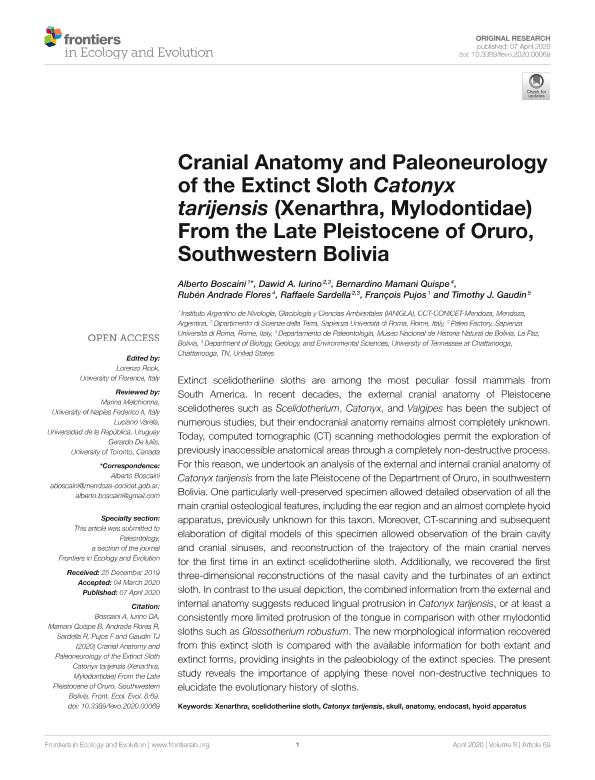Mostrar el registro sencillo del ítem
dc.contributor.author
Boscaini, Alberto

dc.contributor.author
Iurino, Dawid A.
dc.contributor.author
Mamani Quispe, Bernardino
dc.contributor.author
Andrade Flores, Rubén
dc.contributor.author
Sardella, Raffaele
dc.contributor.author
Pujos, François Roger Francis

dc.contributor.author
Gaudin, Timothy

dc.date.available
2021-10-07T15:11:48Z
dc.date.issued
2020-04
dc.identifier.citation
Boscaini, Alberto; Iurino, Dawid A.; Mamani Quispe, Bernardino; Andrade Flores, Rubén; Sardella, Raffaele; et al.; Cranial Anatomy and Paleoneurology of the Extinct Sloth Catonyx tarijensis (Xenarthra, Mylodontidae) From the Late Pleistocene of Oruro, Southwestern Bolivia; Frontiers Media; Frontiers in Ecology and Evolution; 8; 4-2020; 1-16
dc.identifier.issn
2296-701X
dc.identifier.uri
http://hdl.handle.net/11336/143132
dc.description.abstract
Extinct scelidotheriine sloths are among the most peculiar fossil mammals from South America. In recent decades, the external cranial anatomy of Pleistocene scelidotheres such as Scelidotherium, Catonyx, and Valgipes has been the subject of numerous studies, but their endocranial anatomy remains almost completely unknown. Today, computed tomographic (CT) scanning methodologies permit the exploration of previously inaccessible anatomical areas through a completely non-destructive process. For this reason, we undertook an analysis of the external and internal cranial anatomy of Catonyx tarijensis from the late Pleistocene of the Department of Oruro, in southwestern Bolivia. One particularly well-preserved specimen allowed detailed observation of all the main cranial osteological features, including the ear region and an almost complete hyoid apparatus, previously unknown for this taxon. Moreover, CT-scanning and subsequent elaboration of digital models of this specimen allowed observation of the brain cavity and cranial sinuses, and reconstruction of the trajectory of the main cranial nerves for the first time in an extinct scelidotheriine sloth. Additionally, we recovered the first three-dimensional reconstructions of the nasal cavity and the turbinates of an extinct sloth. In contrast to the usual depiction, the combined information from the external and internal anatomy suggests reduced lingual protrusion in Catonyx tarijensis, or at least a consistently more limited protrusion of the tongue in comparison with other mylodontid sloths such as Glossotherium robustum. The new morphological information recovered from this extinct sloth is compared with the available information for both extant and extinct forms, providing insights in the paleobiology of the extinct species. The present study reveals the importance of applying these novel non-destructive techniques to elucidate the evolutionary history of sloths.
dc.format
application/pdf
dc.language.iso
eng
dc.publisher
Frontiers Media

dc.rights
info:eu-repo/semantics/openAccess
dc.rights.uri
https://creativecommons.org/licenses/by/2.5/ar/
dc.subject
ANATOMY
dc.subject
CATONYX TARIJENSIS
dc.subject
ENDOCAST
dc.subject
HYOID APPARATUS
dc.subject
SCELIDOTHERIINE SLOTH
dc.subject
SKULL
dc.subject
XENARTHRA
dc.subject.classification
Paleontología

dc.subject.classification
Ciencias de la Tierra y relacionadas con el Medio Ambiente

dc.subject.classification
CIENCIAS NATURALES Y EXACTAS

dc.title
Cranial Anatomy and Paleoneurology of the Extinct Sloth Catonyx tarijensis (Xenarthra, Mylodontidae) From the Late Pleistocene of Oruro, Southwestern Bolivia
dc.type
info:eu-repo/semantics/article
dc.type
info:ar-repo/semantics/artículo
dc.type
info:eu-repo/semantics/publishedVersion
dc.date.updated
2021-09-06T20:06:02Z
dc.journal.volume
8
dc.journal.pagination
1-16
dc.journal.pais
Suiza

dc.journal.ciudad
Lausana
dc.description.fil
Fil: Boscaini, Alberto. Consejo Nacional de Investigaciones Científicas y Técnicas. Centro Científico Tecnológico Conicet - Mendoza. Instituto Argentino de Nivología, Glaciología y Ciencias Ambientales. Provincia de Mendoza. Instituto Argentino de Nivología, Glaciología y Ciencias Ambientales. Universidad Nacional de Cuyo. Instituto Argentino de Nivología, Glaciología y Ciencias Ambientales; Argentina
dc.description.fil
Fil: Iurino, Dawid A.. Università degli studi di Roma "La Sapienza"; Italia
dc.description.fil
Fil: Mamani Quispe, Bernardino. Museo Nacional de Historia Natural de la Paz; Bolivia
dc.description.fil
Fil: Andrade Flores, Rubén. Museo Nacional de Historia Natural de la Paz; Bolivia
dc.description.fil
Fil: Sardella, Raffaele. Università degli studi di Roma "La Sapienza"; Italia
dc.description.fil
Fil: Pujos, François Roger Francis. Consejo Nacional de Investigaciones Científicas y Técnicas. Centro Científico Tecnológico Conicet - Mendoza. Instituto Argentino de Nivología, Glaciología y Ciencias Ambientales. Provincia de Mendoza. Instituto Argentino de Nivología, Glaciología y Ciencias Ambientales. Universidad Nacional de Cuyo. Instituto Argentino de Nivología, Glaciología y Ciencias Ambientales; Argentina
dc.description.fil
Fil: Gaudin, Timothy. University Of Tennessee At Chattanooga; Estados Unidos
dc.journal.title
Frontiers in Ecology and Evolution
dc.relation.alternativeid
info:eu-repo/semantics/altIdentifier/url/https://www.frontiersin.org/articles/10.3389/fevo.2020.00069/full?&utm_source=Email_to_authors_&utm_medium=Email&utm_content=T1_11.5e1_author&utm_campaign=Email_publication&field=&journalName=Frontiers_in_Ecology_and_Evolution&id=522964
dc.relation.alternativeid
info:eu-repo/semantics/altIdentifier/doi/http://dx.doi.org/10.3389/fevo.2020.00069
Archivos asociados
